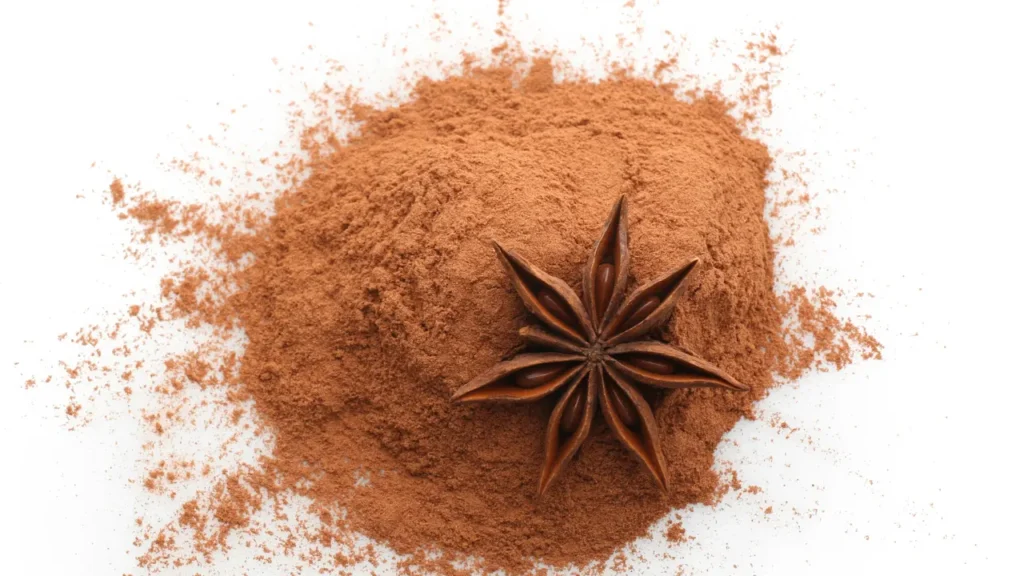Scientifically referred to as Illicium verum, star anise is a spice that is highly prized for both its unique star-shaped figure and anise-like flavor, which is mostly brought about by the presence of anethole. It is a customary component of many international culinary traditions, especially those of Asian cuisines. But because of its many health advantages, its use goes beyond the kitchen and into traditional and modern medicine. This article explores the properties, health advantages, best dosage, adverse effects, possible interactions with other drugs, and responsible usage of star anise as a nootropic supplement.
You May Also Like:
Should You Try CBD for Focus? Here Are the Facts.
CBD for Concentration: 3 Epic Benefits that Boost Your Focus
Star Anise: Benefits, Dosage, Side Effects, Drug Interactions, and Other Important Information is an original (NootropicsPlanet) article.
Nature of Star Anise
Native to Southwest China and Vietnam, star anise is a spice derived from an evergreen tree in the Illiciaceae family. Its name comes from the star-shaped pericarp that encloses the seed, a characteristic that adds to the plant’s visual attractiveness and contains a wide variety of medicinal substances. Due to its numerous health advantages, the spice is widely used in traditional medicine, the pharmaceutical field, and culinary applications. As introduced, it is well-known for its anise flavor, which is related to the presence of anethole.
Health Benefits of Star Anise
Antimicrobial Effects
Star anise possesses strong antibacterial qualities because of substances like anethole, which have been demonstrated to impede the development of fungi, bacteria, and viruses. Thus, star anise holds the potential to be an invaluable natural medicine for treating infections and boosting the body’s immunological response.
Antioxidant Activity
Vitamin C and flavonoids are the two antioxidants present in star anise. They aid in the neutralization of free radicals, thereby averting oxidative stress and cellular damage. This antioxidant ability promotes general health and may offer defense against long-term illnesses, such as those that impair cognitive abilities.
Digestive Health
Star anise has long been used to ease gastrointestinal discomfort symptoms, lessen bloating, and enhance digestion. Its antispasmodic qualities ease cramps and lessen gas production by relaxing the digestive tract.
Respiratory Health
Star anise’s expectorant qualities can help with congestion relief, cough relief, and improved breathing. It’s frequently used to treat respiratory issues in herbal drinks and medicines.
Immune System Support
Shikimic acid, a substance utilized in the creation of antiviral drugs, may be found in star anise. This, together with its antibacterial qualities, makes it an all-natural immune system booster that aids in the body’s defense which can prevent infections.
Cognitive Function
The impact of star anise on cognitive functioning has not been thoroughly studied, however bioactive components of the plant, like anethole, have been connected to possible neuroprotective benefits. Star anise may help improve cognitive function, including attention, memory, and alertness. These properties come from the ability of star anise to indirectly regulate neurotransmitter activity while exerting anti-inflammatory and antioxidant properties.
Cardiovascular Health
The cardiovascular health benefits of the spice’s anti-inflammatory and antioxidant properties include lowering cholesterol, controlling blood pressure, and preventing blood clot formation—all of which lower the risk of heart disease.
Hence, it is clear that the abundance of bioactive chemicals found in star anise contributes to its wide range of health advantages.

Chemistry of Star Anise
One of the most potent bioactive substances found in star anise is anethole. With its flavor and aroma reminiscent of licorice, anethole predominates in the star anise sensory profile. Nevertheless, star anise’s chemical repertory also includes other important components that all contribute to its various therapeutic qualities, such as limonene, linalool, and shikimic acid.
- Anethole is primarily responsible for the spice’s distinctive flavor and has been shown to exhibit anti-inflammatory, antimicrobial, and potentially estrogenic activities. Its structure allows it to interact with biological systems in a manner that influences various physiological processes.
- Limonene and Linalool are monoterpenes that contribute to the spice’s aromatic profile. Limonene has been researched for its anti-anxiety, anti-inflammatory, and anticancer properties, while linalool offers sedative and anti-anxiety effects, among other health benefits.
- Shikimic Acid is a critical precursor in the biosynthesis of many aromatic compounds. Notably, it is used in the production of the antiviral medication oseltamivir (Tamiflu), highlighting star anise’s role in pharmaceutical applications.
All of these substances work together to provide star anise its therapeutic benefits. Its intricate chemical makeup highlights the potential interactions and synergistic effects that may occur in the body after ingestion.
Physiological Mechanism of Action of Star Anise
The physiological mechanisms through which star anise exerts its effects are multifaceted, primarily due to its diverse chemical makeup. The primary mechanism of action that is highlighted is how anethole interacts with the body’s neurological system.
Neurotransmitter Modulation: Anethole mimics the actions of serotonin in the brain because of its structural resemblance to the neurotransmitter. Cognitive abilities including learning, memory, alertness, and mood management may all be improved by this connection. One possible explanation for anethole’s anxiolytic (anxiety-reducing) and antidepressant properties is its impact on serotonin receptors.
Anti-inflammatory and Antioxidant Effects: Anethole is one of the star anise constituents’ anti-inflammatory qualities. It helps reduce brain inflammation, which is linked to cognitive loss. Its antioxidant function also reduces oxidative stress, which shields neurological cells from harm. The entire health and cognitive function of the brain are supported by this dual protective mechanism.
Immune System Support: Star anise may strengthen the immune system through the immunomodulatory actions of shikimic acid and other substances. A strong immune system can lower the frequency of illnesses that affect cognitive health, which indirectly supports cognitive processes even though this effect is not nootropic.
These processes show the potential benefits of star anise as a nootropic supplement by illuminating how the spice’s bioactive chemicals may interact with the body to boost cognitive functioning. To completely comprehend their significance for cognitive health and general well-being, more scientific research is necessary to determine the precise routes and interconnections within the human body.

Optimal Dosage of Star Anise
The lack of comprehensive studies and the variability of individual reactions make it difficult to determine the ideal dosage of star anise for cognitive enhancement. The amount of star anise used medicinally varies greatly based on the type of supplement (e.g., whole, powdered, or extract) and its intended application. For general health purposes, for example, 1-2 grams of the spice is usually used per cup when consumed as a tea. To guarantee safety and effectiveness, speaking with a healthcare professional is advised for information on specific dosages and nootropic usage.
Side Effects of Star Anise
Greater dosages of star anise may cause negative effects even if it is normally safe for ingestion. Allergy responses, nausea, and oral and digestive system discomfort are among the side effects of star anise. To note, Illicium verum, also known as Chinese star anise, must be distinguished from Illicium anisatum, also known as Japanese star anise, which is poisonous and should not be consumed.
There’s not enough information available on the safety of star anise supplements for pregnant and nursing women, so they should proceed with caution and speak with a healthcare professional before using them.

Potential Substance Interactions with Star Anise
Star anise may affect the activity of enzymes involved in drug metabolism, which may cause some negative interactions with drugs that are processed by the liver. This interaction may reduce the medication’s efficacy or raise the possibility of adverse consequences. Furthermore, star anise may interact with psychiatric drugs due to its serotonin-mimicking qualities, especially SSRIs and other drugs that influence serotonin levels. Before adding star anise to any pharmaceutical regimen, those using any kind of medication must speak with a healthcare provider.
Best Responsible Use of Star Anise
Taking a prudent stance is essential for anyone considering utilizing star anise to improve their cognitive function. Users should start with low doses to measure tolerance. Also, they should take periodic breaks to reduce the possibility of reliance or bad responses.
Furthermore, the star anise used must be of a high grade; purchasing the spice from reliable vendors guarantees purity and security. People with pre-existing medical issues or those on medication should pay special attention to professional advice to guarantee the safe and effective use of star anise due to its complex effects and interactions.
Star Anise:
Conclusion
In a nutshell, if you find the star-shaped form of this plant to be fascinating, you will surely be more surprised when learning about all the health benefits and effects of this uniquely shaped herb. It is believed to help in digestive health, respiratory health, immune system, cognitive function, and cardiovascular health.
Anethole, star anise’s most notable component, is mainly responsible for the spice’s distinctive flavor profile and also anti-inflammatory and antimicrobial effects. There is no set dosage yet for this supplement given its different forms in supplemental types. It is safe for you to consume around 1 to 2 grams of tea daily. For further confirmation, you need to seek professional medical advice to guide you in your supplementation journey.

References:
- Star Anise: Benefits, Uses and Potential Risks. Retrieved from:https://www.healthline.com/nutrition/star-anise
- Is Star Anise Good for You? Retrieved from:https://www.verywellhealth.com/star-anise-benefits-8597823
- Illicium verum (Star Anise) and Trans-Anethole as Valuable Raw Materials for Medicinal and Cosmetic Applications. Retrieved from: https://www.ncbi.nlm.nih.gov/pmc/articles/PMC8839413/
- Star anise (Illicium verum): Chemical compounds, antiviral properties, and clinical relevance. Retrieved from: https://pubmed.ncbi.nlm.nih.gov/31997473/
Important Note: The information contained in this article is for general informational purposes only, and should not be construed as health or medical advice, nor is it intended to diagnose, prevent, treat, or cure any disease or health condition. Before embarking on any diet, fitness regimen, or program of nutritional supplementation, it is advisable to consult your healthcare professional in order to determine its safety and probable efficacy in terms of your individual state of health.
Regarding Nutritional Supplements Or Other Non-Prescription Health Products: If any nutritional supplements or other non-prescription health products are mentioned in the foregoing article, any claims or statements made about them have not been evaluated by the U.S. Food and Drug Administration, and such nutritional supplements or other health products are not intended to diagnose, treat, cure, or prevent any disease.


